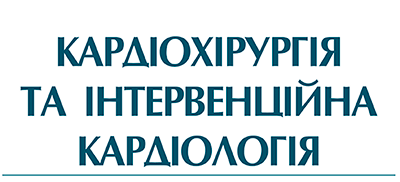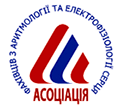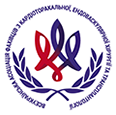Recurrence of atrial fibrillation and late cardiovascular events in patients with persistent atrial fibrillation after restoration of sinus rhythm
U.P. Chernyaha-Royko, N.S. Pavlyk, M.S. Sorokivskyy, A.V. Aker, O.J. Zharinov
References
1. Оrder of the Ministry of Health of Ukraine 15.06.2016 N 597(in Ukr).
2. Alcaraz R, Hornero F, Rieta J.J. et al. Noninvasive time and frequency predictors of long-standing atrial fibrillation early recurrence after electrical cardioversion. Pacing Clin Electrophysiol.– 2011;34(10):1241–1250. doi: 10.1111/j.1540-8159.2011.03125.x
3. Alzahrani T, McCaffrey J, Mercader M. et al. Rate versus rhythm control in patients with normal to mild left atrial enlargement: insights from the AFFIRM Trial. J Atr Fibrillation.– 2018;11(3):2067. doi: 10.4022/jafib.2067
4. Connolly S.J, Crijns H.J, Torp-Pedersen C. et al. Analysis of stroke in ATHENA: a placebo-controlled, double-blind, parallel-arm trial to assess the efficacy of dronedarone 400 mg BID for the prevention of cardiovascular hospitalization or death from any cause in patients with atrial fibrillation/atrial flutter. Circulation.– 2009;120(13):1174–1180. doi: 10.1161/CIRCULATIONAHA.109.875252
5. Corley SD, Epstein AE, DiMarco JP. et al. Relationships Between Sinus Rhythm, Treatment, and Survival in the Atrial Fibrillation Follow-Up Investigation of Rhythm Management (AFFIRM). Study Circulation. 2004;109:1509–1513. doi: 10.1161/01.CIR.0000121736.16643.11
6. Forkmann M, Schwab C, Edler D. at al. Characteristics of early recurrences detected by continuous cardiac monitoring influencing the long-term outcome after atrial fibrillation ablation. J Cardiovasc Electrophysiol. 2019;30(10). Р. 1886–1893. doi: 10.1111/jce.14109
7. Kelly JP, DeVore AD, Wu J. et al. Rhythm control versus rate control in patients with atrial fibrillation and heart failure with preserved ejection fraction: insights from get with the guidelines-heart failure. J Am Heart Assoc.– 2019;8(24):e011560. doi: 10.1161/JAHA.118.011560
8. Kirchhof P, Benussi S, Kotecha D. et al. ESC Guidelines for the management of atrial fibrillation developed in collabo¬ration with EACTS. Eur Heart J. 2016;37(38):2893–2962. doi: 10.1093/ejcts/ezw313
9. Miura K, Ikemura N, Kimura T. et al. Treatment strategies and subsequent changes in the patient-reported quality-of-life among elderly patients with atrial fibrillation. Am Heart J. 2020;21 (222):83–92. doi: 10.1016/j.ahj.2020.01.011
10. Müller P, Schiedat F, Dietrich JW. et al. Reverse atrial remodeling in patients who maintain sinus rhythm after electrical cardioversion: evidence derived from the measurement of total atrial conduction time assessed by PA-TDI interval. J Echocardiogr. – 2014;12(4):142–150. doi: 10.1007/s12574-014-0227-z
11. Rienstra M, Vermond RA, Crijns HJ. et al. Asymptomatic persistent atrial fibrillation and outcome: results of the RACE study. Heart Rhythm. 2014;11(6):939–945. doi: 10.1016/j.hrthm.2014.03.016
12. Roy D. Rationale for the Atrial Fibrillation and Congestive Heart Failure(AF-CHF) trial. Card Electrophysiol Rev.– 2003;7(3):208–210. doi: 10.1023/B:CEPR.0000012383.63580.c8
13. Shah R, Manesh M. et al. Primary and key secondary results from the ROCKET AF trial, and their implications on clinical practice. Ther Adv Cardiovasc Dis. 2017;11(3):105–120. doi: 10.1177/1753944716663156
14. Vamos M, Calkins H, Kowey PR. et al. Efficacy and safety of dronedarone in patients with a prior ablation for atrial fibrillation/flutter: Insights from the ATHENA study. Clin Cardiol 2020;43(3):291–297. doi: 10.1002/clc.23309
15. Weijs B, Limantoro I, Delhaas T. et al. Cardioversion of persistent atrial fibrillation is associated with a 24-hour relapse gap: Observations from prolonged postcardioversion rhythm monitoring. Clin Cardiol. – 2018;41(3):366–371. doi: 10.1002/clc.22877
16. Xiong N, Shen J, Wu B.J. et al. Factors influencing cognitive function in patients with atrial fibrillation: a cross-sectional clinical study. Int Med Res. 2019;47(12):6041–6052. doi: 10.1177/0300060519882556
| [PDF] | [Contents] |








